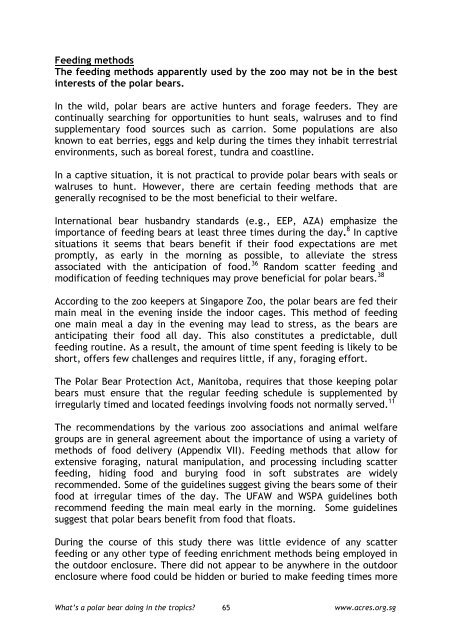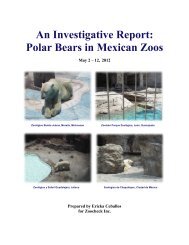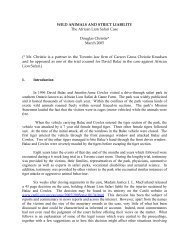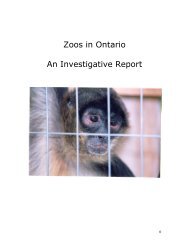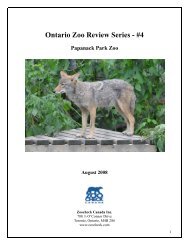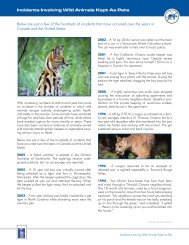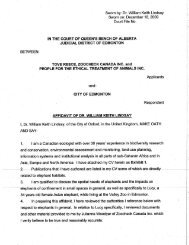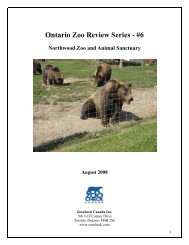What's a Polar Bear Doing in the Tropics? - Animal Concerns ...
What's a Polar Bear Doing in the Tropics? - Animal Concerns ...
What's a Polar Bear Doing in the Tropics? - Animal Concerns ...
You also want an ePaper? Increase the reach of your titles
YUMPU automatically turns print PDFs into web optimized ePapers that Google loves.
Feed<strong>in</strong>g methodsThe feed<strong>in</strong>g methods apparently used by <strong>the</strong> zoo may not be <strong>in</strong> <strong>the</strong> best<strong>in</strong>terests of <strong>the</strong> polar bears.In <strong>the</strong> wild, polar bears are active hunters and forage feeders. They arecont<strong>in</strong>ually search<strong>in</strong>g for opportunities to hunt seals, walruses and to f<strong>in</strong>dsupplementary food sources such as carrion. Some populations are alsoknown to eat berries, eggs and kelp dur<strong>in</strong>g <strong>the</strong> times <strong>the</strong>y <strong>in</strong>habit terrestrialenvironments, such as boreal forest, tundra and coastl<strong>in</strong>e.In a captive situation, it is not practical to provide polar bears with seals orwalruses to hunt. However, <strong>the</strong>re are certa<strong>in</strong> feed<strong>in</strong>g methods that aregenerally recognised to be <strong>the</strong> most beneficial to <strong>the</strong>ir welfare.International bear husbandry standards (e.g., EEP, AZA) emphasize <strong>the</strong>importance of feed<strong>in</strong>g bears at least three times dur<strong>in</strong>g <strong>the</strong> day. 8 In captivesituations it seems that bears benefit if <strong>the</strong>ir food expectations are metpromptly, as early <strong>in</strong> <strong>the</strong> morn<strong>in</strong>g as possible, to alleviate <strong>the</strong> stressassociated with <strong>the</strong> anticipation of food. 36 Random scatter feed<strong>in</strong>g andmodification of feed<strong>in</strong>g techniques may prove beneficial for polar bears. 38Accord<strong>in</strong>g to <strong>the</strong> zoo keepers at S<strong>in</strong>gapore Zoo, <strong>the</strong> polar bears are fed <strong>the</strong>irma<strong>in</strong> meal <strong>in</strong> <strong>the</strong> even<strong>in</strong>g <strong>in</strong>side <strong>the</strong> <strong>in</strong>door cages. This method of feed<strong>in</strong>gone ma<strong>in</strong> meal a day <strong>in</strong> <strong>the</strong> even<strong>in</strong>g may lead to stress, as <strong>the</strong> bears areanticipat<strong>in</strong>g <strong>the</strong>ir food all day. This also constitutes a predictable, dullfeed<strong>in</strong>g rout<strong>in</strong>e. As a result, <strong>the</strong> amount of time spent feed<strong>in</strong>g is likely to beshort, offers few challenges and requires little, if any, forag<strong>in</strong>g effort.The <strong>Polar</strong> <strong>Bear</strong> Protection Act, Manitoba, requires that those keep<strong>in</strong>g polarbears must ensure that <strong>the</strong> regular feed<strong>in</strong>g schedule is supplemented byirregularly timed and located feed<strong>in</strong>gs <strong>in</strong>volv<strong>in</strong>g foods not normally served. 11The recommendations by <strong>the</strong> various zoo associations and animal welfaregroups are <strong>in</strong> general agreement about <strong>the</strong> importance of us<strong>in</strong>g a variety ofmethods of food delivery (Appendix VII). Feed<strong>in</strong>g methods that allow forextensive forag<strong>in</strong>g, natural manipulation, and process<strong>in</strong>g <strong>in</strong>clud<strong>in</strong>g scatterfeed<strong>in</strong>g, hid<strong>in</strong>g food and bury<strong>in</strong>g food <strong>in</strong> soft substrates are widelyrecommended. Some of <strong>the</strong> guidel<strong>in</strong>es suggest giv<strong>in</strong>g <strong>the</strong> bears some of <strong>the</strong>irfood at irregular times of <strong>the</strong> day. The UFAW and WSPA guidel<strong>in</strong>es bothrecommend feed<strong>in</strong>g <strong>the</strong> ma<strong>in</strong> meal early <strong>in</strong> <strong>the</strong> morn<strong>in</strong>g. Some guidel<strong>in</strong>essuggest that polar bears benefit from food that floats.Dur<strong>in</strong>g <strong>the</strong> course of this study <strong>the</strong>re was little evidence of any scatterfeed<strong>in</strong>g or any o<strong>the</strong>r type of feed<strong>in</strong>g enrichment methods be<strong>in</strong>g employed <strong>in</strong><strong>the</strong> outdoor enclosure. There did not appear to be anywhere <strong>in</strong> <strong>the</strong> outdoorenclosure where food could be hidden or buried to make feed<strong>in</strong>g times moreWhat’s a polar bear do<strong>in</strong>g <strong>in</strong> <strong>the</strong> tropics?65www.acres.org.sg


